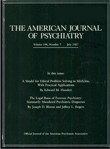Role of Sexual Abuse in the Etiology of Borderline Personality Disorder
This is a superbly written and edited book that quickly and clearly answers the question implied by the title and then goes into rich detail on recent research examining issues and questions about the etiology of borderline personality disorder. The first chapter, written by the editor, gives a succinct but pithy review of the conceptualization of borderline personality disorder. Zanarini summarizes what she refers to as the first and second generations of studies of the pathogenesis of borderline personality disorder. She then describes “the start of a third generation of studies of the etiology” of borderline personality disorder, which are collected together in this book. She briefly describes the studies and their findings, which I found piqued my interest in reading the respective chapters for more detail. She points out that the studies share a number of conceptual and methodologic features setting them apart from previous research in this field. These studies assess a range of pathological childhood experiences rather than looking almost exclusively at sexual abuse; examine the facets of sexual abuse rather than simplistically assuming that all sexual abuse has the same effect on the development of borderline personality disorder; and apply multivariate analyses to determine significant findings from the wide variety of factors measured and recorded in the studies.
The chapter authors present a veritable panoply of research examining the etiology of borderline personality disorder. These include factors such as childhood sexual abuse, other childhood factors, maternal attachment, development of dissociation and self-mutilation, self-destructiveness, familial environment, and physical trauma and neurological vulnerability. Additionally, two chapters discuss theories of etiology and their application to the treatment of patients with borderline personality disorder. I found all the chapters to be eminently readable and logically coherent while also providing me with new knowledge and a new perspective about the complexity of this disorder. I will be more subtle and detailed in my history taking and have a new respect for patients' struggles dealing and succeeding with the stressors of living.
Zanarini states that “the evidence suggesting a complex etiology for BPD is also strenuously ignored by the clinicians who believe that sexual abuse per se is both a necessary and a sufficient precondition for the development of BPD. Although appealing in its simplicity, this view is simply not consonant with the relevant research findings. No study, including our own, which reports on the childhood experiences of an extremely impaired group of inpatients, has found that all borderline patients report having been sexually abused, and not all sexually abused patients in these studies are borderline” (p. 39). These chapters repeatedly document this and examine the complexity of this disorder, rather than looking for simple answers. The clinical relevance of the studies and their findings will be of interest to all clinicians who assess, diagnose, and treat patients with borderline personality disorder. I felt that the studies dealing with those patients who frequently mutilate or hurt themselves and those who repeatedly attempt suicide provided me with a richer perspective on the meaning of these behaviors than I previously had.
The editor is to be congratulated for providing the kind of guidance to authors that results in a book rich in detail, readable, and applicable to researchers and clinicians alike. Each chapter provides a good balance between hard data and clinical application. There are abundant references for each chapter. I recommend this book highly for researchers and clinicians alike who work with patients who suffer from borderline personality disorder. I feel the research methodology sets a new standard and overall approach for the effective study of all personality disorders as we try to better understand these complex illnesses and behaviors. As Zanarini writes, these patients' “pain and their future well-being are what is important, not our need to defend closely held theoretical positions.”



